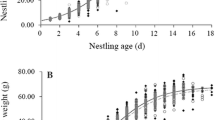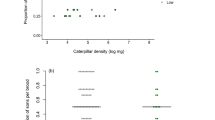Abstract
Sex allocation theory explains how parents should allocate reproductive effort to the rearing of sons and daughters. A central premise is that there is room for individual optimization of brood sex ratios as a function of the relative rearing costs of sons and daughters, the fitness return curves for sons and daughters, and the total amount of reproductive resources available. When sons are more expensive to raise than daughters, and fitness returns per unit investment are equal for the two sexes, we show with a simple graphical model that large clutches should be female-biased. We tested this prediction in a field study of the White-throated Dipper Cinclus cinclus in Norway. In this species, males are nearly 20 % heavier than females, and the predominant mating system is social monogamy with little or no extrapair paternity, indicative of similar reproductive variances for the two sexes. We found a significant deficit of males (27 % males) for the largest clutch size (=6 eggs) in the population and no deviation from parity for five-egg clutches (47 % males). This contrast could not be explained by any sex-biased mortality rate at the egg or nestling stages, and thus suggests facultative adjustment of the primary sex ratio. We also verified a sexual dimorphism in growth rates at the nestling stage. Our results indicate that different rearing costs of sons and daughters may select for clutch-size dependent sex-ratio adjustment in size-dimorphic species.
Zusammenfassung
Das primäre Geschlechterverhältnis variiert mit der Gelegegröße bei der Wasseramsel ( Cinclus cinclus ), einer Art mit sexuellem Größendimorphismus
Die Theorie der Geschlechtsallokation erklärt, wie Eltern ihren Fortpflanzungsaufwand auf die Aufzucht von Söhnen und Töchtern verteilen sollten. Eine zentrale Voraussetzung ist, dass die Gelegenheit zur individuellen Optimierung des Geschlechterverhältnisses innerhalb der Brut besteht, in Abhängigkeit von den relativen Aufzuchtskosten von Söhnen und Töchtern, den Fitnessertragskurven für Söhne und Töchter und der Gesamtmenge verfügbarer Fortpflanzungsressourcen. Wir zeigen mit einem einfachen graphischen Modell, dass, wenn die Aufzucht von Söhnen kostenintensiver ist als die von Töchtern und die Fitnesserträge pro Investitionseinheit für die beiden Geschlechter gleich sind, große Gelege zu Weibchen hin verschoben sein sollten. Wir haben diese Vorhersage in einer Feldstudie an der Wasseramsel (Cinclus cinclus) in Norwegen getestet. Bei dieser Art sind die Männchen fast 20 % schwerer als die Weibchen, und das vorherrschende Paarungssystem ist soziale Monogamie mit wenig oder gar keiner Fremdvaterschaft, was auf ähnliche reproduktive Varianz für die beiden Geschlechter schließen lässt. Wir fanden ein signifikantes Männchendefizit (27 % Männchen) für die höchste Gelegegröße (= 6 Eier) in der Population und keine Abweichung von einem ausgeglichenen Geschlechterverhältnis für Gelege mit fünf Eiern (47 % Männchen). Dieser Unterschied konnte nicht mit höherer Mortalität eines Geschlechts im Ei- oder Nestlingsstadium erklärt werden und deutet daher auf eine fakultative Anpassung des primären Geschlechterverhältnisses hin. Wir haben außerdem Geschlechtsdimorphismus in der Wachstumsrate im Nestlingsstadium bestätigt. Unsere Ergebnisse deuten darauf hin, dass unterschiedliche Aufzuchtskosten für Söhne und Töchter bei Arten mit Größendimorphismus eine von der Gelegegröße abhängige Anpassung des Geschlechterverhältnisses begünstigen dürften.


Similar content being viewed by others
References
Alonso-Alvarez C, Velando A (2003) Female body condition and brood sex ratio in Yellow-legged Gulls Larus cachinnans. Ibis 145:220–226
Andersson JS, Wester SAL (1971) Length of wing, bill, and tarsus as a character of sex in the Dipper Cinclus cinclus. Ornis Scand 2:75–79
Benito MM, González-Solís J (2007) Sex ratio, sex-specific chick mortality and sexual size dimorphism in birds. J Evol Biol 20:1522–1530
Bonier F, Martin PR, Wingfield JC (2007) Maternal corticosteroids influence primary offspring sex ratio in a free-ranging passerine bird. Behav Ecol 18:1045–1050
Charnov EL (1982) The theory of sex allocation. Princeton University Press, Princeton
Cockburn A, Double M (2008) Cooperatively breeding Superb Fairy-wrens show no facultative manipulation of offspring sex ratio despite plausible benefits. Behav Ecol Sociobiol 62:681–688
Delmore KE, Kleven O, Laskemoen T, Crowe SA, Lifjeld JT, Robertson RJ (2008) Sex allocation and parental quality in Tree Swallows. Behav Ecol 19:1243–1249
Efteland S (2001) Vekt, vektvariasjonar og vengemål hos fossekall i SV-Norge. Cinclus Scandinavicus 14:5–7 (in Norwegian with English summary)
Ellegren H, Gustafsson L, Sheldon BC (1996) Sex ratio adjustment in relation to paternal attractiveness in a wild bird population. Proc Natl Acad Sci USA 93:11723–11728
Ellegren H, Sheldon BC (1997) New tools for sex identification and the study of sex allocation in birds. Trends Ecol Evol 12:255–259
Ewen JG, Cassey P, Moller AP (2004) Facultative primary sex ratio variation: a lack of evidence in birds? Proc R Soc B 271:1277–1282
Fiala KL (1980) On estimating the primary sex-ratio from incomplete data. Am Nat 115:442–444
Fiala KL, Congdon JD (1983) Energetic consequences of sexual size dimorphism in nestling Red-winged Blackbirds. Ecology 64:642–647
Fisher RA (1930) The genetical theory of natural selection. Clarendon, Oxford
Frank SA (1990) Sex allocation theory for birds and mammals. Ann Rev Ecol Syst 21:13–55
Griffin AS, Sheldon BC, West SA (2005) Cooperative breeders adjust offspring sex ratios to produce helpful helpers. Am Nat 166:628–632
Griffiths R, Double MC, Orr K, Dawson RJG (1998) A DNA test to sex most birds. Mol Ecol 7:1071–1075
Howe HF (1976) Egg size, hatching asynchrony, and brood reduction in the Common Grackle. Ecology 75:1195–1207
Komdeur J, Daan S, Tinbergen J, Mateman C (1997) Extreme adaptive modification in sex ratio of the Seychelles Warbler’s eggs. Nature 385:522–525
Komdeur J, Magrath MJL, Krackow S (2002) Pre-ovulation control of hatchling sex ratio in the Seychelles Warbler. Proc R Soc B 269:1067–1072
Krackow S, Neuhäuser M (2008) Insights from complete-incomplete brood sex-ratio disparity. Behav Ecol Sociobiol 62:469–477
Lack D (1947) The significance of clutch size. Ibis 89:302–352
Lack D (1966) Population studies of birds. Clarendon, Oxford
Leech DI, Hartley IR, Stewart IRK, Griffith SC, Burke T (2001) No effect of parental quality or extrapair paternity on brood sex ratio in the Blue Tit (Parus caeruleus). Behav Ecol 12:674–680
Lessells CM (1991) The evolution of life histories. In: Krebs JR, Davies NB (eds) Behavioral ecology an evolutionary approach, 3rd edn. Blackwell, Oxford, pp 32–68
Love OP, Chin EH, Wynne-Edwards KE, Williams TD (2005) Stress hormones: a link between maternal condition and sex-biased reproductive investment. Am Nat 166:751–766
Øigarden T, Borge T, Lifjeld JT (2010) Extrapair paternity and genetic diversity: the White-throated Dipper Cinclus cinclus. J Avian Biol 41:248–257
Pettifor RA, Perrins CM, McCleery RH (1988) Individual optimization of clutch size in Great Tits. Nature 336:160–162
Pike TW, Petrie M (2003) Potential mechanisms of avian sex manipulation. Biol Rev 78:553–574
Pike TW, Petrie M (2006) Experimental evidence that corticosterone affects offspring sex ratios in quail. Proc R Soc B 273:1093–1098
Pryke SR, Griffith SC (2009) Genetic incompatibility drives sex allocation and maternal investment in a polymorphic finch. Science 323:1605–1607
R Development Core Team (2011) R: a language and environment for statistical computing. R Foundation for Statistical Computing, Vienna, ISBN 3-900051-07-0. http://www.R-project.org
Radford AN, Blakey JK (2000) Is variation in brood sex ratios adaptive in the Great Tit (Parus major)? Behav Ecol 11:294–298
Ramsay SM, Mennill DJ, Otter KA, Ratcliffe LM, Boag PT (2003) Sex allocation in Black-capped Chickadees Poecile atricapilla. J Avian Biol 34:134–139
Røskaft E, Slagsvold T (1985) Differential mortality of male and female offspring in experimentally manipulated broods of the Rook. J Anim Ecol 54:261–266
Sheldon BC (1998) Recent studies of avian sex ratios. Heredity 80:397–402
Sheldon BC, Andersson S, Griffith SC, Örnborg J, Sendecka J (1999) Ultraviolet colour variation influences Blue Tit sex ratios. Nature 402:874–877
Slagsvold T (1982) Clutch size variation in passerine birds: the nest predation hypothesis. Oecologia 54:159–169
Snow DW, Perrins C (1998) The birds of the western Palearctic, concise edn. Oxford University Press, Oxford
Stearns SC (1977) Evolution of life-history traits—critique of theory and a review of data. Ann Rev Ecol Syst 8:145–171
Stearns SC (1992) The evolution of life histories. Oxford University Press, Oxford
Trivers RL, Willard DE (1972) Natural selection of parental ability to vary the sex ratio of offspring. Science 179:90–92
Tyler S, Ormerod S (1994) The dippers. T. & A.D. Poyser, London
Uller T, Badyaev AV (2009) Evolution of “determinants” in sex-determination: a novel hypothesis for the origin of environmental contingencies in avian sex-bias. Semin Cell Dev Biol 20:304–312
West S (2009) Sex allocation. Princeton University Press, Princeton
Westerdahl H, Bensch S, Hansson B, Hasselquist D, von Schantz T (1997) Sex ratio variation among broods of Great Reed Warblers Acrocephalus arundinaceus. Mol Ecol 6:543–548
Williams GC (1979) The question of adaptive sex ratio in outcrossed vertebrates. Proc R Soc B 205:567–580
Acknowledgments
We thank A. Mæhlen for assistance in the field, local members of the Norwegian Ornithological Society for access to their nest boxes, Lars Erik Johannessen for help with statistics, and Arild Johnsen, Kevin Omland, Thomas Friedl, and two anonymous reviewers for comments on the manuscript. Financial support was provided by the County Governor of Hedmark.
Author information
Authors and Affiliations
Corresponding author
Additional information
Communicated by T. Friedl.
Rights and permissions
About this article
Cite this article
Øigarden, T., Lifjeld, J.T. Primary sex ratios vary with clutch size in the size-dimorphic White-throated Dipper Cinclus cinclus . J Ornithol 154, 91–97 (2013). https://doi.org/10.1007/s10336-012-0874-7
Received:
Revised:
Accepted:
Published:
Issue Date:
DOI: https://doi.org/10.1007/s10336-012-0874-7




